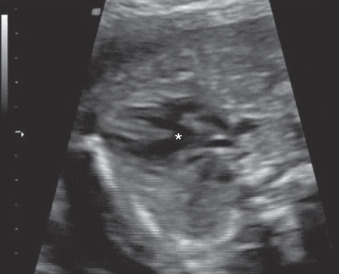Abstract
Double-outlet right ventricle is a rare congenital heart disease in which both vessels originate mainly from the right ventricle. Its diagnosis on routine ultrasound (US) examination is challenging because the four-chamber view is usually normal. The prognosis in cases detected prenatally is generally poor, due to a high association with chromosomal, extracardiac, and cardiac anomalies.
Keywords
congenital heart defect, conotruncal anomaly, double outlet right ventricle
Disease
Definition
DORV encompasses a spectrum of lesions in which both outflow tracts connect to the right ventricle entirely or predominantly.
Prevalence and Epidemiology
DORV accounts for 4% to 8% of prenatal congenital heart diseases (CHDs). The high association of DORV with cardiac, extracardiac, and chromosomal anomalies is responsible for its lower postnatal incidence (1% to 3%).
Associated anomalies are frequent in fetuses with DORV. Chromosomal abnormalities are found in 10% to 20% of cases; trisomies 18 and 13 are the most frequent, and trisomy 21 and 22q11 microdeletion are also found in DORV. Other commonly associated cardiac anomalies are atrioventricular septal defect, cardiosplenic syndromes, aortic coarctation, mitral atresia, and straddling or overriding of the atrioventricular valves with consequent hypoplasia of the underlying ventricle. Finally, extracardiac anomalies are present in two-thirds of cases, especially gastrointestinal and central nervous system anomalies.
Etiology and Pathophysiology
The etiology is multifactorial. DORV consists of a large ventricular septal defect (VSD). The VSD may have a variable disposition, including a subaortic or subpulmonary isolated defect; a doubly committed defect, immediately below the valves and spanning both outflow tracts; and a noncommitted defect, low in the septum and far from the semilunar outflow valves.
Isolated subaortic and subpulmonary VSDs are the most frequent types found in prenatal and surgical series, respectively. Subaortic VSD is usually associated with a normal orientation of the great arteries, with some degree of pulmonary obstruction. This form resembles tetralogy of Fallot (TOF) from a pathophysiologic point of view. In cases with subpulmonary VSD, the great arteries are usually malpositioned, and the defect resembles transposition of the great arteries (TGA) with VSD.
A doubly committed VSD is characterized by complete absence of the muscular outlet septum, is perimembranous, and is considered noncommitted because it opens into the right ventricle beneath the septal leaflet of the tricuspid valve, or because the tension apparatus of the atrioventricular valves is interposed between the margins of the defect and the subarterial outflow tracts.
Manifestations of Disease
Clinical Presentation
The clinical presentation depends on the location of the VSD, the relationship of great arteries, and the degree of outflow tract obstruction, resembling TOF, VSD, or TGA.
Imaging Technique and Findings
Ultrasound.
Prenatal diagnosis with ultrasound (US) is challenging. The four-chamber view appears normal, unless there is a left axis deviation or a large VSD that extends posteriorly, which is then visible on the four-chamber view.
- •
The four-chamber view is typically normal, unless other anomalies are associated. Levocardia can also be present in this conotruncal anomaly.
- •
On the five-chamber view or long-axis view, there is usually a perimembranous VSD with an overriding vessel. To be considered as DORV, the semilunar valve should override the VSD by at least 50% ( Fig. 87.1 ).











